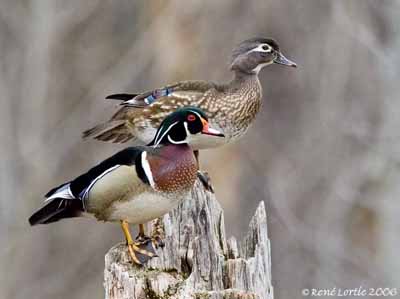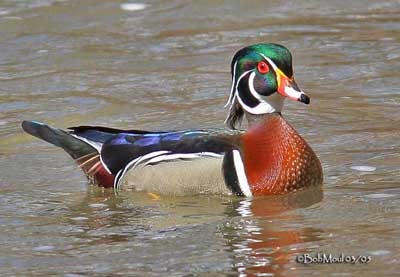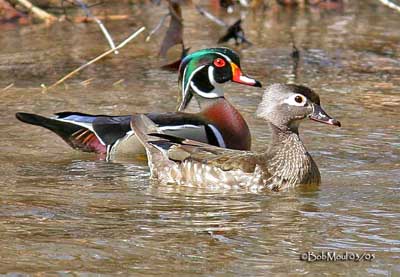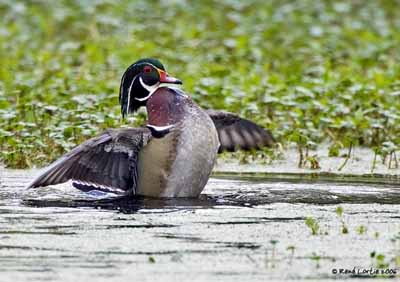
Fr: Canard carolin
All : Brautente
Esp : Pato Joyuyo
Ital: Anatra sposa
Nd: Carolinaeend
Sd: Brudand
Photographers:
Tom Grey
Tom Grey's Bird Pictures
René Lortie
http://rlortie.ca
Bob Moul
Nature Photography
Tom Merigan
Tom Merigan’s Photo Galleries
Texte de Nicole Bouglouan
Sources:
HANDBOOK OF THE BIRDS OF THE WORLD vol 1 by Josep del Hoyo-Andrew Elliot-Jordi Sargatal - Lynx Edicions - ISBN: 8487334105
GUIDE DES CANARDS, DES OIES ET DES CYGNES – de Steve Madge - Delachaux et Niestlé - ISBN: 2603013769
THE HANDBOOK OF BIRD IDENTIFICATION FOR EUROPE AND THE WESTERN PALEARCTIC by Mark Beaman, Steve Madge - C.Helm - ISBN: 0713639601
FIELD GUIDE TO THE BIRDS OF NORTH AMERICA - National Geographic Society - ISBN: 0792274512
All About Birds (Cornell Lab of Ornithology)
Bird Web (Seattle Audubon Society)
What Bird-The ultimate Bird Guide (Mitchell Waite)
Wood Duck
Aix sponsa
Anseriforme Order – Anatidae Family
BIOMETRICS:
Length: 43-51 cm
Wingspan: 70-76 cm
Weight: M: 680g – F: 540 g
DESCRIPTION:
The Wood Duck is a medium-sized duck. Male and female shows a crest on the head, a long rectangular tail, white belly and white streaks on the rear of the wings.

The male is slightly larger than the female. Its head has a long crest with green, blue and purple iridescences. We can see two parallel white lines, one from the bill base to the rear eye, and other to the nape.
Eyes are red with orange eye-ring. The bill is bright coloured: we can see a fine yellow line at the edge of the base, then the red base with white patches on the sides, and a central black band running to the tip. The bill base tapers into a point on the lores.

The breast is dark reddish finely spotted white. A double bar white and black separate the breast from the yellowish-buff flanks, themselves separated from the back by a white line. Back and tail are black with blue and green iridescences.
Underwing is dark, with spotted black and white coverts. Legs and webbed feet are yellow.

Male in eclipse resembles female, but the bill is more coloured.
The female is duller with brownish-grey plumage. She has white patch around the eye, and the base of the grey bill is bordered white. The throat and the chin are white, breast and flanks are grey-brown spotted whitish.
The upperparts are greyish-brown with blue and purple iridescences. Legs and webbed feet are dull yellow.

The juvenile resembles female but duller. It has grey bill, and the eyes are brown with indistinct yellow eye-ring.

The chicks are dark brown above with small white spots on wings and back. They are pale yellow below, and we can see a black line from the eye to the nape. The bill is blue-grey. Legs and webbed feet are black.
VOICE: SOUNDS BY XENO-CANTO
The Wood Duck female utters a loud « oo-eek, oo-eek » when disturbed o at take-off. The male gives a tiny undulating whistle “jwiiip” or “swiiiooo, kip, kip, kip”.
The adult can give about twelve different calls and the chicks have yet five. Adults call mainly when alarmed or during the displays. The female utters different sounds to attract her mate or to call the chicks.
The chicks utter some calls 2-3 days after hatching. At three months of age, they have the adult repertoire.

HABITAT:
The Wood Duck is a North American species. It frequents numerous habitats, including wooded areas along the banks of lakes. It also lives in freshwater ponds, quiet rivers, and need well wooded areas for nesting.
RANGE:
North America. The population of the east coast breeds from S Canada to Florida, and that of the west coast from British Columbia to California. Both populations winter southwards, according to each breeding areas.

BEHAVIOUR:
The Wood Duck starts to display in autumn, but the true displays occur in spring. This species is monogamous and the male remains with the same female during the whole breeding season.

The male uses its beautiful plumage to attract the female, while she utters a loud sound to attract a male. The displays start with mutual preening. The male expose and move wings and tail, raising them frequently to display the colours. Mutual preening shows both mates pecking head and neck of their partner. After the breeding season, males migrate in order to moult.

The Wood Duck walks, flies and swims. It is diurnal, and except females and chicks, they sleep in the water. They are gregarious and often gather in large numbers at night to sleep.
To feed, it dips the head into the water to reach the aquatic vegetation. It pecks at the surface while dabbling, but it also forages on the ground.

The Wood Duck migrates in pairs or in small groups. It is not territorial. In order to protect its mate, the male chases away intruders, pecks at rivals and moves the wings strongly. The fights are often short. To threaten another bird, it moves the bill in jerky fashion and hits hard.

When a predator approaches the nest-site, the female utters its alarm call and the chicks run forwards to the water in order to protect themselves, while their mother swims far from them, performing the “broken-wing” display to attract the predator.
85 to 90% of the chicks die within two weeks after hatching, due to predation.
FLIGHT:
The Wood Duck has fast and agile flight, even amongst the trees of its habitat. The head is raised but the bill is turned downwards.


REPRODUCTION:
The Wood Duck nests alone in trees, between 6 and 15 metres height, close to the water, sometimes above, but also at more than two kilometres. The nest is built in cavity, and lined with wood shavings and down.
The female lays 6-15 whitish eggs. She incubates during about one month. The chicks hatch between 6 and 18 hours after the shell is broken. They leave the nest about 24 hours after hatching and their mother call them away from the nest after watching for predators on intruders. The chicks jump down and usually alight unscathed.
As soon as they leave the nest, they start to feed themselves, but they will be independent about 56-70 days after hatching. The female rears them alone. The young reach their sexual maturity at one year.
Sometimes, more than 15 eggs are laid in the same nest because other females use an occupied nest which becomes a “communal nest”.

DIET:
The Wood Duck is omnivorous, but feeds mainly on vegetal matter, water lentils and rice. It also consumes hazelnuts, fruits, aquatic plants and their seeds, some invertebrates and aquatic insects.

PROTECTION / THREATS / STATUS:
The Wood Duck declined in the century 19th but populations become stable and increasing in the century 20th, thanks to the nest-boxes which help for the reproduction.
This decline is due to the beauty of the plumage. There was a great demand for the feathers, as well for ornaments as to make “flies” for fishing.
In the East of America, deforestation, drainage of wetlands and hunting pressure involved almost its extinction.
The predators such as birds of prey, foxes, alligators, reptiles and large fishes play an important role in some decreases. Eggs are destroyed by woodpeckers and starlings which also are cavity-nesters.
